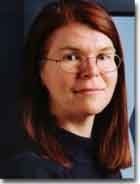Janet Conrad
“I'm not your typical physicist,”says Janet Conrad, the 36-year old Columbia University physicist best known for her neutrino physics research at Fermi National Accelerator Laboratory in Batavia, Ill. “If you were to pick out the kid in the class who would be a physicist, you wouldn't pick me.”
Conrad is a young, female physicist in a field that even today is overwhelmingly male. She says, though, that it is more than just a matter of gender that sets her apart. It is a gift for explaining the esoteric concepts of particle physics in simple, everyday terms for the general public.
“I've always thought I was a little different from those in my classes, and I've learned to use it, to bring something to physics,” Conrad says. “People like the way I explain things. I think it is an unusual ability in the field of physics.”

Photo: Fermi National Accelerator Laboratory
She also finds physics research fun, something she says derives from a deep love for the work she does.
“I am very focused and I've been in love with this stuff from the time I first arrived at Fermilab after my junior year in college,”Conrad says. “I think it is fun and I want the everyone else to think it is fun, too.”
Today Conrad is one of the chief scientists on a project at Fermilab to determine whether or not the neutrino has mass. That is, she wants to know if the neutrino “weighs” anything or if, as has been believed until recently, it has no mass whatsoever.
The neutrino is a ubiquitous but incredibly elusive subatomic particle whose existence was first “discovered”in 1930 merely as a way to balance the energy amounts of a physics equation. It was not until 1953 that the first neutrinos were detected in an actual experiment.
Neutrinos permeate the Universe. Conrad says there are believed to be about a million of them in every “gallon” of space. Over a million trillion of them whiz through you every day. Nevertheless, these ghostly particles are almost impossible to detect because they so rarely interact with ordinary matter. In the so-called “Standard Model”—the basic conceptual framework that physicists use to describe all the fundamental particles in the universe—the neutrino has zero mass.
However, there are reasons to believe that the neutrino may indeed have a non-zero mass. What's more, Conrad says, no matter how incredibly small that mass may be, because there are so many neutrinos, the way physicists understand the structure of the physical universe would be profoundly altered. The Standard Model itself would need to be substantially revised.
“We don't know how to put a neutrino [with mass] in our Standard Model,”she says. “In the Standard Model they are massless, but there is no compelling theoretical reason for that.”
Conrad herself has been likened to a photon—the zero mass particle that travels at the maximum possible speed and is the carrier of all electromagnetic radiation, including visible light. If the energetic Conrad and her colleagues find a positive result—that is, if they show that the neutrino does have mass—then they will be responsible for a fundamental revision in how scientists understand and describe our universe.











